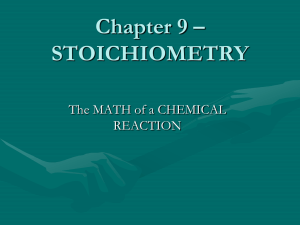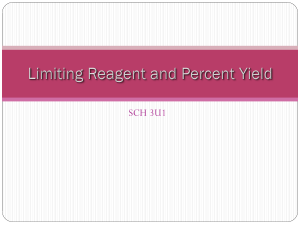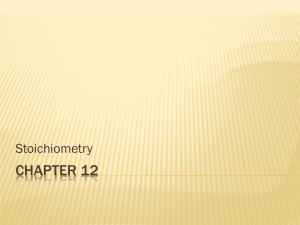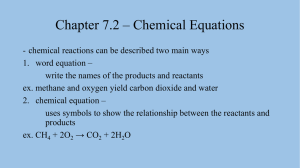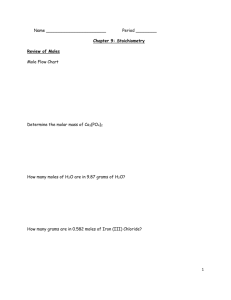Chemical Calculations II: Reactions
advertisement
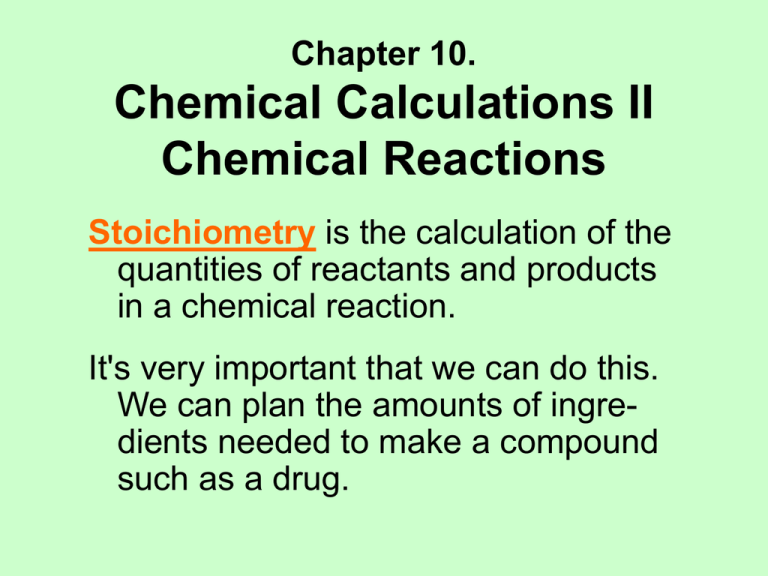
Chapter 10. Chemical Calculations II Chemical Reactions Stoichiometry is the calculation of the quantities of reactants and products in a chemical reaction. It's very important that we can do this. We can plan the amounts of ingredients needed to make a compound such as a drug. Conservation of Mass Atomic theory states that atoms are not created or destroyed in a chemical reaction, they just trade partners. The Law of Conservation of Mass states that mass is neither created nor destroyed in a chemical reaction. The reaction equation for a chemical change uses these principles. Conservation of Mass CH4 + 2 O2 CO2 + 2 H2O Each side of the equation has 1 carbon, 4 oxygens, 4 hydrogens Conservation of Mass CH4 + 2 O2 16.05 g CH4 +64.00 g O2 80.05 g reactants CO2 + 2 H2O 44.01 g CO2 +36.04 g H2O 80.05 g products Chemical Equations A chemical equation is a representation of a chemical reaction that uses chemical symbols instead of words to describe the changes that occur in the reaction. It's a sentence that describes something. It's a mathematical equation that describes a quantitative relationship. Chemical Equations Parts of a chemical equation: (a) Reactants are compounds that are present at the start of a reaction. Their formulas are shown on the left of the reaction arrow (b) Products are compounds that result from the reaction. Their formulas are shown on the right of the reaction arrow. (c) The reaction arrow is read as "to produce" and can be treated mathematically like "=". (d) Coefficients show the number of moles of each compound in the reaction. Chemical Equations A balanced chemical equation has coefficients that show the number of moles of reactants and products, such that the same number of each type of atoms appear on both sides of the equation. A skeleton equation shows reactants and products, but no coefficients. It must be balanced to be useful in chemical calculations. Chemical Equations Balancing chemical equations by inspection involves some guesswork and testing. Start with the most complex compounds, and work toward the simpler compounds and elements. Work with coefficients. Do not change subscripts in chemical formulas! Make sure the result shows the lowest wholenumber ratio of coefficients. Chemical Equations Examples: Balance the following skeleton equations. (a) (b) (c) (d) H2 + O2 H2O Fe2O3 + CO Fe + CO2 C3H8 + O2 CO2 + H2O C4H10 + O2 CO2 + H2O Competency II-1 Equations and Moles 3 H2 + N2 2 NH3 This balanced equation can be read at the molecular level or the molar level. The 3:1:2 ratio holds for molecules and moles, and for any quantities of reactants. 9 moles of H2 will react with 3 moles of N2 to produce 6 moles of NH3 Equations and Moles 3 H2 + N2 2 NH3 We can treat the mole ratios as conversion factors and calculate relative moles of reactants and products based on these. 3 mol H2 1 mol N2 2 mol NH3 3 mol H2 2 mol NH3 1 mol N2 Equations and Moles 3 H2 + N2 2 NH3 How many moles of NH3 are produced if 4.85 moles of H2 are reacted with excess N2? And how realistic is that problem? We can't usually measure things in moles. We have to use mass and convert. Reaction Calculations Typical types of calculations that are done for chemical reactions: (a) I have X amount of a reactant. How much product can I get? (b) I want to make X amount of a product. How much of each reactant do I need? (c) When I make X amount of the desired product, how much of the side products will be produced? Reaction Calculations These are called theoretical yield calculations, and they allow us to determine how much of a product is formed, or a reactant is needed, based on given quantities. Reaction Calculations In a theoretical yield problem, look for (a) "Wants" the quantity requested. (b) "Gots" the quantity given. Enough information is given to figure out moles of "gots". (c) "Wants/Gots Factor" the # of moles of the requested quantity divided by the # of moles of the given quantity. The balanced reaction equation gives these numbers. Reaction Calculations Steps: (a) Calculate moles of Gots (b) Multiply that by Wants/Gots factor to get moles of Wants (c) Multiply moles of Wants by its molar mass to get mass of Wants Reaction Calculations Example: Fe2O3 + 3 CO 2 Fe + 3 CO2 With 500 g of Fe2O3 and excess CO, how much iron metal (Fe) can be produced? Reaction Calculations Example: Fe2O3 + 3 CO 2 Fe + 3 CO2 With 500 g of Fe2O3 and excess CO, (a) How much CO will be consumed? (b) How much CO2 will be produced? Competency II-2 Limiting Reactants We often don't use exactly the amounts of reactants called for in the balanced equation. One (usually the cheapest!) is present in excess. The limiting reactant is the reactant that is entirely consumed when the reaction stops. Other reactants are present in excess. Limiting Reactants If I have 55 nuts, 48 bolts, and 92 washers, how many sets of 1 bolt, 1 nut, 2 washers can I make? What part limits me? What is left over? Limiting Reactants Chemistry is the same way. CH4O + NaI CH3I + NaOH If one starts with 750 g of both reactants, what is the theoretical yield of CH3I (the maximum that can be obtained)? Which reactant is limiting? Work this as two theoretical yield problems, the lower result is the theoretical yield and the reactant that produces it is limiting. Actual and Percent Yield We rarely obtain the theoretical yield of a product. The actual yield is the mass of product obtained in a reaction. It's usually lower than the theoretical yield, sometimes much lower! It's determined by experiment. The percent yield is the ratio actual yield x 100% theoretical yield Actual and Percent Yield Why do we care? Percent yield shows how efficient the reaction is, and/or how well the scientist or student did the reaction. Also, if a reaction routinely gives 50% yield, one had better start with twice the reactant as needed for the calculated theoretical yield! Actual and Percent Yield Example: If my theoretical yield for CH3I was 710 g, but I only isolated 650 g, what was my % yield? Competency II-3

